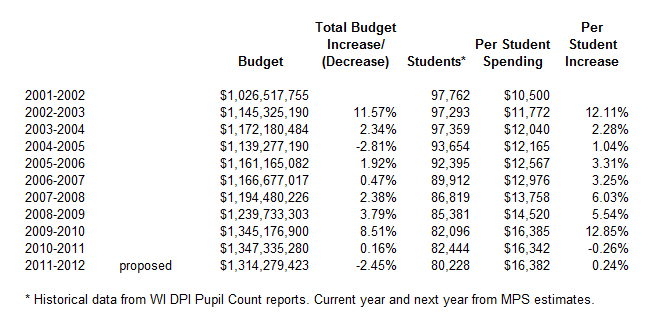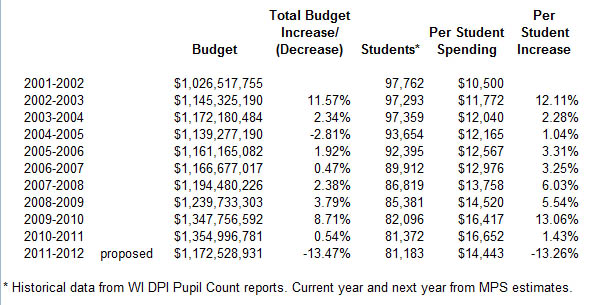This week, public workers’ unions in Wisconsin are up in arms because Governor Scott Walker has issued a budget which seeks to strip the unions of many of their bargaining rights. He wants to make the union members pay their fair share for their pensions and health care costs, and the unions aren’t having it! If Walker’s budget passes, public employees’ unions will only be able to negotiate on compensation, not on benefits.
Of course, the first cry from the teachers is that IT’S FOR THE CHILDREN and this budget should not pass. They, along with their private sector supporters, are claiming that teachers are underpaid and that school budgets are being cut. Neither are true. They further claim that forcing a rollback in the lavish (yes, lavish) benefits of teachers will create a shortage of teachers. I disagree.
Let’s talk first about teacher compensation and potential shortages. I am specifically going to address Milwaukee Public Schools (MPS), because I live in the district and am directly affected by the tax money used to support MPS. I have demonstrated time and again how the teachers in MPS are anything but poorly compensated.
The average teacher in MPS is receiving a compensation package of $100,005 per year as detailed here, while students remain unable to read and do basic math. (And it’s not because Milwaukee is an urban district and the children have problems. Other urban districts have succeeded where Milwaukee fails.) An analysis of data collected by the Bureau of Labor Statistics further demonstrates how well teachers are paid compared to other professions.
Let’s be honest. A compensation package of over $100,000 per year for a job which gives you summers off isn’t bad. In fact, it is really, really good. I’m not saying the job is easy or that I’m willing to do it. I’m just saying that if you take the emotion out of it and compare the working hours and pay/benefits to other professional occupations, teachers are doing well!
So this idea that we need to control employee costs for public employees (and in this article, specifically for teachers) isn’t that crazy. Will there be a shortage of teachers? I doubt it.
I have a friend who has been teaching for over 15 years for MPS. Last year she was unsure if she would have a job because of a reduction in the number of teachers. Translation: There are more people trying to get teaching jobs in MPS than there are jobs available. The teachers cry that it’s such a difficult job and they’re so poorly paid, yet people are banging down the doors trying to get that job. Even if benefits are reduced, I still predict that there will be plenty of willing teachers available to MPS.
And now, about the budget. When having these political debates, it’s popular to say that school budgets are being cut, class sizes are growing, and there simply isn’t enough money to educate our children. The only one of those statements that is true is the fact that class sizes are growing. In fact, the MPS budget has been growing astronomically.
If you simply look at the district’s total budget in the chart below, you see healthy yearly increases in the amount of money being spent by the district.
If you look at per student spending, the picture becomes even clearer, as you see that Milwaukee Public Schools has been dramatically increasing the amount of money it spends per student educated. To put this in perspective, MPS is currently spending over $16,000 per child, while area private schools are educating children at a cost of $5,000 to $8,000 per child.
![MPS Budget Milwaukee Public Schools Budget]()
Indeed, the MPS budget is not being cut. It has been increased by huge margins. Why? The problem is employee costs. More and more money is going to pay the salaries and benefits, leaving less and less for other costs of running a school district.
The only way to counteract this is by reducing the number of teachers, which ultimately means that class sizes are increased. If we were to control the costs of the employees, there would be more money for other needs within the district. (And no, I”m not talking about cell phones, hotels, advertising, iPods, and other wasteful spending.)
If teachers want to be respected, they will have to argue this issue based on facts, not false statements like “budgets are being cut.” I would further suggest that skipping school to protest in Madison does not help their cause. They claim “it’s for the children,” but skipping school does nothing but hurt those very children.




